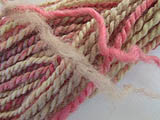 Ply Me a River: Ply Me a River:Understanding Yarns Shopping for yarn can be overwhelming, especially if you're new to the world of knitting and haven't yet developed the ability to "read" yarn. While fiber composition and color do come into play, it's the spin of the yarn that makes the biggest difference in the end. Depending on how it's spun, a yarn can look sleek or lumpy, fluid or fluffy, generic or extraordinary in your finished project. The Spin on Spin The notion of "spin" can be broken down into two parts: ply and twist. Ply indicates the number of separate strands of spun fiber that, when allowed to twist together, form a single strand of yarn. There is no rule about how thick each ply must be, so this cannot be your judge of gauge. For example, a four-ply yarn made of fine plies could be far finer than a two-ply yarn made of thicker plies -- or the opposite could also be true. To experience the ply phenomenon firsthand, all you need to do is take a piece of single-ply yarn and twist it tightly. Then fold the piece in half and watch how the yarn naturally twists back on itself. The resulting yarn in your hands is two-ply. Most standard yarns are either single-ply (one continuous strand of spun fibers) or two-, three-, or four-ply. Worsted vs. Woolen The look of your yarn depends not only on how many plies it has but how the fibers were prepared before being spun together. When all the fibers are combed and carded so that they fall in the same direction, they produce a strong, sleek, and (fiber type permitting) lustruous yarn with high stitch definition. This preparation is called "worsted." Examples of worsted yarns include Hawthorne Cottage English Leicester Longwool and Tregellys two-ply yarn. Another option is a fuzzier, matte-looking yarn spun from fibers that have been allowed to stay in more of a jumbled mass. This is called the "woolen" preparation or spinning method. (Note that the fiber in question doesn't have to be wool to be woolen-spun -- it's merely a matter of semantics.) Woolen yarns tend to produce a fuzzier, more "blurry" surface. Examples of woolen yarns include Jamieson Shetland DK, Marr Haven Fine Wool Yarn, and Maine Merino. In the Beginning: Singles 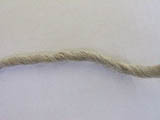 Single-ply yarns are the simplest of all yarns. They run the gamut from White Buffalo unspun pencil roving to the fast-knitting Reynolds Bulky Lopi, Green Mountain Spinnery Mountain Mohair, Cleckheaton Gusto, and Rowan Polar, to Morehouse Farm Merino's fine single-ply lace-weight yarn. They all have one thing in common: a surface that appears smooth and steady because the yarn itself is smooth, steady, and uninterrupted. Single-ply yarns are the simplest of all yarns. They run the gamut from White Buffalo unspun pencil roving to the fast-knitting Reynolds Bulky Lopi, Green Mountain Spinnery Mountain Mohair, Cleckheaton Gusto, and Rowan Polar, to Morehouse Farm Merino's fine single-ply lace-weight yarn. They all have one thing in common: a surface that appears smooth and steady because the yarn itself is smooth, steady, and uninterrupted.From a handspinner's perspective, single-ply yarns (or "singles") are one of the most difficult yarns to spin correctly. This is because if too much spin is applied, the yarn will "bias," or produce an unbalanced fabric that slants in one direction or another rather than producing an even square or rectangle. If you discover bias in your finished garment, there's very little you can do except block the garment into place, and then block and block again. In her book, The Twisted Sisters Sock Workbook, Lynne Vogel discusses ways in which spinners can use a single strand of tightly spun yarn (called a "charged single") to create a spiral, candycane-like effect when knitting in the round. Knitting with Singles On the skein, single-ply yarns tend to have a smooth, fluid surface without those interruptions or "waves" you get with multiple plies (the difference is comparable to a ponytail versus a braid). When knit up, singles tend to produce a cohesive, almost feltlike material. You'll want to be careful working with single-ply yarns, however. That's because there's very little twist to hold the fibers together. If you tug too hard on your yarn, or if you repeatedly snag the yarn with your needle, it may pull apart completely. Design Uses The thicker, more felt-like single-ply yarns have often been used in cold-weather garbs such as Icelandic and Cowichan sweaters. In both cases, color is used as the decorative element, since the yarn does not display elaborate stitch patterns well. These garments are thick, lofty, and extremely warm, keeping out even the harshest of elements. However, single-ply yarns tend to score lower on the wearability tests than their plied counterparts. Again, with less twist to hold the fibers together, they can separate and grow thin when exposed to excess friction. Elbows are the most common victim of wear. True Twist: Plied Yarns 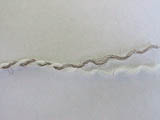 Many knitters insist that yarn isn't yarn unless it has been plied, or until two or more singles have twisted together. Plied yarns tend to be much stronger and more resilient. Depending on how they have been plied, they can have much greater depth and visual complexity than single-ply yarns when knit up. Many knitters insist that yarn isn't yarn unless it has been plied, or until two or more singles have twisted together. Plied yarns tend to be much stronger and more resilient. Depending on how they have been plied, they can have much greater depth and visual complexity than single-ply yarns when knit up.Yarns can be made from loosely plied strands, in which you have only a few twists per inch (such as Jaeger Luxury Tweed), producing smooth and fluid effect; or from closely plied strands, in which you have many twists per inch (such as Halcyon Yarn Botanica), which produces a more pearly, rippled effect. 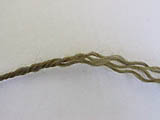 One reason why many commercial yarns are loosely spun and plied is financial rather than aesthetic. For each extra rotation added to each inch of yarn, more electricity is required to run the machines -- and this translates into higher production costs.
One reason why many commercial yarns are loosely spun and plied is financial rather than aesthetic. For each extra rotation added to each inch of yarn, more electricity is required to run the machines -- and this translates into higher production costs.Simple vs. Complex Yarns "Simple" yarns are those composed of two or three plies. Most of your standard over-the-counter yarns fall in this category, including Halcyon Yarn Botanica, Mountain Colors Weaver's Wool, Cherry Tree Hill Supersock, and Jo Sharp Silkroad Aran. Simple yarns are easy to knit, making them ideal for beginners. Depending on how tightly or loosely the plies are brought together, you may encounter some snagging problems, but that's about it. Simple yarns wear well, which is why you'll often see them used for everyday wear. When using finer short-staple fibers in simple yarns, manufacturers will often blend them with a stronger, longer fiber for added durability. An example of this is Classic Elite Lush, which blends the short-staple angora with a longer-staple wool. Complex Yarns 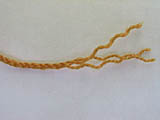 The next category is "complex" yarn, which is composed of multiple strands of yarns that -- themselves -- are composed of multiple strands. When you hear people refer to a yarn as "cabled," this is what they're talking about. The next category is "complex" yarn, which is composed of multiple strands of yarns that -- themselves -- are composed of multiple strands. When you hear people refer to a yarn as "cabled," this is what they're talking about.Complex, or cabled, yarns can have an endless number of plies depending on the patience (and budget) of the yarn manufacturer. For example, Karabella Yarns Aurora 8 is made of eight two-ply strands, while Berroco X-Press is made of 14 two-ply strands. With so many twists at work in each inch of finished yarn, complex yarns tend to be far more durable than simple yarns -- but they can also be more challenging to knit without snagging. For the yarn to be perfectly balanced, the twist in each individual strand must be offset by an equal twist in the opposite direction when the strands are plied together. If the yarn isn't balanced, the plies may come unspun while you're knitting. Depending on how many plies are at work here, this could mean having to manage four, six, or even more strands of yarn at a time. This can also lead to bias problems, as I discovered with Berroco X-Press. Complex yarns are ideally suited for finer, shorter-staple fibers such as cashmere and angora, which need the added twist of the multiple plies to hold the fibers in place. Complex yarns also tend to show off knitted stitches far better than their single and simple counterparts, especially if the plies are tightly spun. This makes them an ideal choice for garments that have complicated stitchwork. Putting Knowledge to Good Use Beyond ply and spin, there are a few other tricks to "reading" yarn. The most useful one is to pull out a foot of yarn and twist it around your finger several times. This is because, while yarn on the skein may look pretty, that's not what you'll see when the yarn is knit up. Short of knitting a test swatch in the store, which may not be appreciated by the store owner, this simple twist test will help give you a better idea of how the yarn looks in shorter increments. To learn more about how to choose the right yarn for a project -- especially if the pattern calls for a yarn other than the one you'd like to use -- read Yarn Swapping: Tips for Making Headache-Free Yarn Substitutions. |
Copyright © 2000-2016 Clara H. Parkes
All rights reserved. Permission to reproduce is required.
All rights reserved. Permission to reproduce is required.
